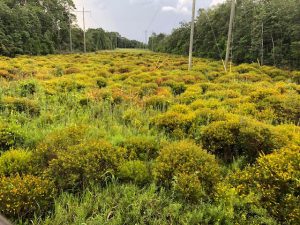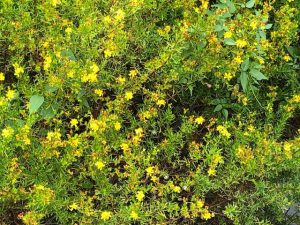
Large swaths of St. John’s Wort (Hypericum spp.) in bloom throughout the Blackwater River floodplain in Milton, Florida. Photo credit: Carrie Stevenson, UF IFAS Extension
Late summer is prime time for floating or canoeing down north Florida’s slow-moving, cold-water rivers. It is favorite summer tradition for our family, floating for hours in inner tubes and stopping to jump off rope swings.
If you drift down just about any north Florida river in the summer, you will likely notice large numbers of low-lying, thick green shrubs along the banks, loaded with tiny yellow flowers. These would be St. John’s wort. In our neck of the woods (or riverside), there are at least 28 species of Hypericum, with 9 of them endemic to the Panhandle. More devoted botanists can differentiate between all the species, but it takes years of study and field experience. All of them have woody stems with thin, evergreen, upright, opposite clusters of leaves, and small bright yellow flowers. Most prefer wet habitats—open marshes, streambanks, swamps, you name it—although 7 species are considered upland varieties. The most common species statewide is Marsh St. John’s Wort (Hypericum fasciculatum), which has softer-appearing leaves that remind me a lot of sand pine needles.

The bright yellow flowers of St. John’s Wort are noticeable throughout the summer in Panhandle wetlands. Photo credit: Carrie Stevenson, UF IFAS Extension
Named for the feast of St. John the Baptist (celebrated in late June, and the plant blooms in summer) and the Old English term for herb (wyrt), St. John’s Wort has long been notable for its medicinal purposes. Research has shown the plant to be particularly effective for treating symptoms of menopause and moderate depression. However, serious drug interactions can occur if taken with prescription medications, so it is imperative to speak with a physician or pharmacist before using St. John’s Wort.
St. John’s Wort also makes a great home landscape plant, as it is highly adaptable to many soil types and sunlight levels.
- Wax Myrtle–a Native Evergreen - December 26, 2025
- Yucca–A Tough and Versatile Native Plant - November 26, 2025
- Blazing Star - November 6, 2025
